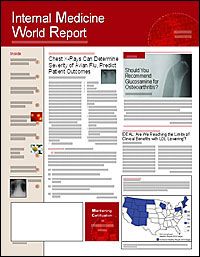Publication
Article
Internal Medicine World Report
Symptoms of Restless Legs Syndrome Affect 10% of All Adults
Author(s):
From the American College of Chest Physicians
Montreal—Surprisingly, 1 in 10 adults reports symptoms of restless legs syndrome (RLS), with regional variation in its prevalence, according to the results of a national sleep survey presented at the 71st annual scientific assembly of the American College of Chest Physicians.
In patients with mild or infrequent symptoms, nonpharmacologic means of treatment should be tried first, whereas pharmacotherapy may be appropriate for patients with more severe symptoms.
In its annual sleep poll, the National Sleep Foundation surveyed a random sample of 1506 adults on aspects of sleep.
A total of 8% of men and 11% of women (9.7% overall) reported symptoms of RLS; these included unpleasant feelings in the legs for at least a few nights each week that were worse at night), reported Barbara A. Phillips, MD, president of the National Sleep Foundation and professor of pulmonary and critical care medicine, University of Kentucky, Lexington.
Among those surveyed, 15% said that they had the symptoms a few nights a week, and 8% said that they had them every night. Of those who reported symptoms more than once a week, 15% said that the feelings were worse at night.
The prevalence of symptoms differed by geographic region. “We found an increas­ed likelihood of RLS in the South and a re­du­ced risk of RLS symptoms in the North­east,” said Dr Phillips.
Adults with RLS symptoms were more likely to have physical and psychiatric conditions, including depression and anxiety. She said that a causal relationship between RLS symptoms and psychiatric disorders cannot be proved; RLS may cause mood disturbance or may be the result of medications used to treat mood disturbance.
Risk factors for RLS—smoking, obesity, and a sedentary lifestyle—are more frequent in individuals with psychiatric illnesses, she added.
Additional risk factors associated with symptoms of RLS were excess weight, unemployment, hypertension, arthritis, gastroesophageal reflux disease, and ­diabetes. Those at risk of RLS also appeared to be at greater risk for sleep apnea and insomnia, and were more ­likely to report taking >30 minutes to fall asleep, having daytime fatigue, and feeling drowsy when driving.
According to Susan Harding, MD, professor of medicine and director of the Sleep Disorders Center at the University of Alabama, Birmingham, identifying aggravators of symptoms is the first step in the treatment of patients with confirmed RLS. Aggravators include sleep deprivation, alcohol (especially red wine), nicotine, caffeine, too much or too little exercise, and medications such as antipsychotics, antidepressants, prochlorperazine, or calcium antagonists.
“I always start out with nonpharmacologic treatments,” said Dr Harding. “However, the evidence [for these] is not very strong. There’s a lot of ­anecdotal evidence.”
Among the nonpharmacologic treatments are maintaining a regular sleep/ wake schedule, avoidance of alcohol and caffeine, engaging in moderate regular exercise before the evening, and cognitive activity exercises.
Previous research indicates that 2% to 3% of patients with a diagnosis of RLS have moderate-to-extreme symptoms, said Dr Phillips. “These are the people who we probably need to treat,” she said.
The only medication that has received FDA approval for the treatment of RLS is ropinirole (Requip). However, because ropinirole has a slow onset of action, it may affect compliance, and so physicians often use dopamine agonists as first-line treatment, said Dr Harding, with symptom relief achieved in 70% to 100% of patients. Levodopa (Larodopa) is the most common dopamine agonist used; open-label studies show good and rapid control of symptoms.
Additional therapies with some evidence behind their efficacy are iron therapy for patients with RLS and iron deficiency, pramipexole (Mirapex) (although it, too, has a slow onset of action), ergot derivatives, atypical anticonvulsants (for pain relief), and benzodiazepines.






